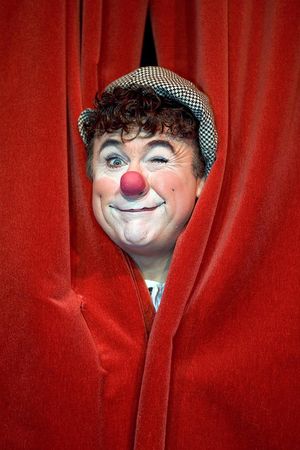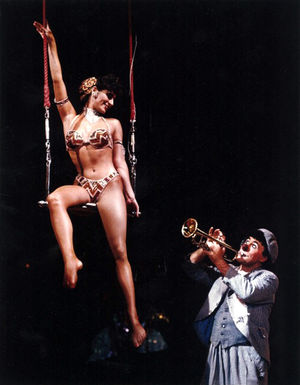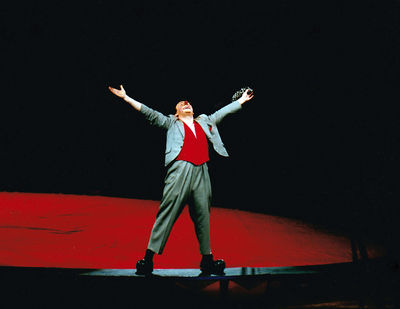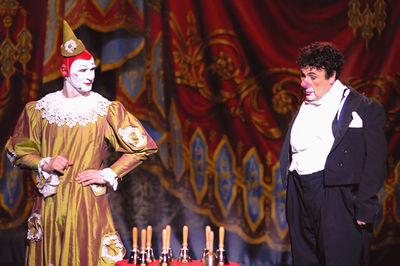Difference between revisions of "David Larible"
From Circopedia
(→A Star Is Born) |
(→Back to Europe) |
||
| Line 65: | Line 65: | ||
David is often invited to perform in international festivals. In 1997, he was awarded the Golden Lion for a career achievement at the [[Wu Quiao Festival]] in China. in 2001, he was invited to appear in a special performance at the [[Bolshoi Circus]] in Moscow, and he returned there in 2015 to star in their production, ''Like''; he has also performed several times at Moscow's [[Circus Nikulin]]. In the winter of 2008, he performed with the Berlin Philharmonic, and in July 2009, he performed for the reopening of the Villa [[Grock]] gardens in Oneglia, Italy, for the 50th anniversary of the legendary clown's death. In 2015, David was presented with the ''Master'' award for the best clown act at the short-lived Master Festival in Sochi, Russia—a sort of Oscar® ceremony of the Russian circus—from the hands of Oleg Popov. | David is often invited to perform in international festivals. In 1997, he was awarded the Golden Lion for a career achievement at the [[Wu Quiao Festival]] in China. in 2001, he was invited to appear in a special performance at the [[Bolshoi Circus]] in Moscow, and he returned there in 2015 to star in their production, ''Like''; he has also performed several times at Moscow's [[Circus Nikulin]]. In the winter of 2008, he performed with the Berlin Philharmonic, and in July 2009, he performed for the reopening of the Villa [[Grock]] gardens in Oneglia, Italy, for the 50th anniversary of the legendary clown's death. In 2015, David was presented with the ''Master'' award for the best clown act at the short-lived Master Festival in Sochi, Russia—a sort of Oscar® ceremony of the Russian circus—from the hands of Oleg Popov. | ||
| − | David Larible has three sisters: Eliana (b.1961), who is married to Bernhard Paul; Cinzia (b.1963), retired from performing, who married former circus artist Moreno Gerardi; and the aerialist Vivien Larible (b.1967), married to the trapeze flyer [[The España Family|Noe España]]. David married Mexican aerialist America Jimenez in 1981, and together they have two children, Shirley (b.1989) and Pierre David (b.1997). Shirley, trained in Paris by [[Victor Fomine]] and in Montreal by [[André Simard]], works in German varieté shows with her straps act—a rare specialty among female performers; David Larible, Jr. | + | David Larible has three sisters: Eliana (b.1961), who is married to Bernhard Paul, the founder of Circus Roncalli; Cinzia (b.1963), retired from performing, who married former circus artist Moreno Gerardi; and the aerialist Vivien Larible (b.1967), married to the trapeze flyer [[The España Family|Noe España]]. David married Mexican aerialist America Jimenez in 1981, and together they have two children, Shirley (b.1989) and Pierre David (b.1997). Shirley, trained in Paris by [[Victor Fomine]] and in Montreal by [[André Simard]], works in German varieté shows with her straps act—a rare specialty among female performers; David Larible, Jr. has become a very talented juggler. |
==See Also== | ==See Also== | ||
Revision as of 21:54, 12 November 2022
Clown
By Raffaele de Ritis
Born June 23, 1957 in Novara, Italy, David Larible has been seen in many European circus rings, on television, and on theater stages; he had an amazing career in the United States and Mexico, and has made frequent appearances in Russia and Eastern Europe. His is by far the most famous (and most copied) circus clown in the world.
David is the first traditional circus augusteIn a classic European clown team, the comic, red-nosed character, as opposed to the elegant, whiteface Clown. to have brilliantly synthesized the virtuosity of old musical augustes and the classic clown entrée(French) Clown piece with a dramatic structure, generally in the form of a short story or scene. repertoire with new trends such as the Russian lyrical interpretation of clowning, and the street-rooted audience participation that appeared in Europe in the early 1980s.
A former acrobat, and an accomplished and versatile musician, David has a fertile imagination and a wonderful sensibility that led him to continuously work on new comedy material: He has, at the time of this writing (2009), developed about twenty different pieces, some of which he has gathered into a one-man show for the theater stage.
Ancient Roots and Early Vocation
The son of Eugenio Larible, a Washington trapeze(orig.: "trapèze à la Washington" – French) A heavy trapeze with a flat bar, on which an aerialist performs balancing tricks. Originated by the American aerialist H. R. Keyes Washington (1838-1882). star in the 1960-70s, and equestrienneA female equestrian, or horse trainer, horse presenter, or acrobat on horseback. Lucina Casartelli, David Larible is a seventh generation circus performer. His family is linked to some of the oldest dynasties in the business, notably Travaglia (Adele Travaglia married his great-grandfather, Pierre Larible), and Gerardi (Rosina Gerardi married his grandfather, Pietro Casartelli). These families are also related to the aristocracy of the Italian circus: Loyal, Dell’Acqua, Zoppis, Colombaioni, Huesca, Togni, and many others.
As a child, David followed his parents in the top European circuses of the 1960s (Pinder, Knie, Schumann), and was exposed to some of the best performers of the period. At the same time he studied ballet, and trumpet at the Music Conservatory of Verona.
He was about six years old when he discovered the great Spanish clowns Tonetti, in whose Circo Atlas his family was performing. They left a lasting impression on him. During the same Spanish tour, his grandfather took him to the movies, and little David discovered Pierre Etaix’s film materpiece, Yoyo, which definitely triggered his vocation for clowning.
In 1970, while he was with his parents at Circus Scott in Sweden, David began to appear in the show as an all-around performer. Back in Italy the following year, he became part of the company of Circo Casartelli, which was then becoming one of Italy’s largest circuses and belonged to his mother’s large family. There, David performed as a trapeze flyerAn acrobat that is propelled in the air, either in a flying act, or in an acrobatic act (i.e. teeterboard)., equestrian, tumbler, as an anonymous musician in the circus orchestra—and a no less anonymous member of Clown Alley.
He began to play trumpet solos during the ring changes; one evening, David was introduced to the famous composer Nino Rota, who was attending a performance. In 1972 (the year Circo Casartelli adopted the name "Medrano," which had been acquired from the Austrian Svoboda family), David became part of a new roller-skating act his father Eugenio had put together with David’s aunt Rosanna, and his uncle Sergio Larible. A few years later, he was included into another successful family act, a Gaucho fantasy replete with bolleadoras and drum playing, which he performed in a Casartelli-owned circus his father was managing for a season in Italy and Greece, the Circo di Barcelona.
Clown By Accident
In 1978, the two Larible family's acts (Gauchos and roller-skaters) were booked by Switzerland’s Circus Nock. An accident forced the featured clowns to leave the show and the Laribles accepted to quickly put together a classic clown entrée(French) Clown piece with a dramatic structure, generally in the form of a short story or scene.: For the first time, David appeared as an augusteIn a classic European clown team, the comic, red-nosed character, as opposed to the elegant, whiteface Clown., alongside his father, Eugenio, as his clownGeneric term for all clowns and augustes. '''Specific:''' In Europe, the elegant, whiteface character who plays the role of the straight man to the Auguste in a clown team.. They performed a clown classic, the "goose act." For the 1979 season, Nock asked the Laribles to continue to perform as clowns with a new act—this time a version of the classic "Restaurant" entrée(French) Clown piece with a dramatic structure, generally in the form of a short story or scene. performed on roller skates.
In 1980, the Laribles joined Germany’s Circus Krone, where they stayed for ten seasons. They had been hired for their Gaucho and roller-skating acts; the clowns were the famous Francescos. But in 1981, another unexpected incident pushed David back into clowning: Circus Krone's longtime house augusteIn a classic European clown team, the comic, red-nosed character, as opposed to the elegant, whiteface Clown., Klein Helmut, had left, and a three-minute reprise(French) Short piece performed by clowns between acts during prop changes or equipment rigging. (See also: Carpet Clown) was needed to maintain the timing of the show.
The Krone management offered David to perform a short version of Oleg Popov’s cook parody: David accepted, on the condition that he could do it his own way. His passion for clowning was growing, but opportunities to satiate it in the ring were few. The best David obtained was the possibility to warm-up the audience in the ring before the beginning of the show. He also used his emerging augusteIn a classic European clown team, the comic, red-nosed character, as opposed to the elegant, whiteface Clown. character in the new Washington trapeze(orig.: "trapèze à la Washington" – French) A heavy trapeze with a flat bar, on which an aerialist performs balancing tricks. Originated by the American aerialist H. R. Keyes Washington (1838-1882). act of his sister, Vivien, who began performing in the show.
David’s interests for a particular style of clowning also emerged more clearly: As a child, he didn’t like the "Anglo-Saxon" heavy makeup used by some augustes. During his formative years, he observed and admired the gentler styles of Victor Chabri, Charlie Rivel (even though Rivel used a heavy makeup), The Rudi-Llatas, and Oleg Popov. He also admired the sometimes poetic Soviet school of clowning, the emerging Circus Roncalli, which gave an important place to clowning, and he was impressed by the first street comedians who involved their audience in their work—something that was still taboo in the traditional circus world of the early 1980s.
A Star Is Born
In 1982, opportunity knocked when the German ZDF tlevision channel asked David to create clown pieces for its show, “Circus, Tiere, Clowns und Akrobaten”. This association lasted seven years, during which David created dozens of short pieces. It is at that time that he introduced his first two original creations (later widely copied): The paper bag gag, which involved the audience, and the "Juggling Ballerina," in which he juggled scarves in a tutu outfit to classical music.
The Laribles alternated their Circus Krone seasons with winter engagements in Italy, where David had better opportunities to fully develop his clown work: With Wioris Togni in 1982, Cesare Togni in 1983, Medrano-Casartelli in 1984 and 1985, Darix Togni in 1986 and 1987.While he was working at Circus Krone—where he still performed his three-minute reprise(French) Short piece performed by clowns between acts during prop changes or equipment rigging. (See also: Carpet Clown) in the ring and the warm-up—the International Circus Festival of Monte Carlo approached David and asked him to perform as a reprise(French) Short piece performed by clowns between acts during prop changes or equipment rigging. (See also: Carpet Clown) augusteIn a classic European clown team, the comic, red-nosed character, as opposed to the elegant, whiteface Clown. to cover the many ring changes that are necessary during the Festival’s performances. David accepted enthusiastically: He was at long last recognized as a full-fledged clownGeneric term for all clowns and augustes. '''Specific:''' In Europe, the elegant, whiteface character who plays the role of the straight man to the Auguste in a clown team.. His style of clowning clicked with the Festival’s knowledgeable audience, and to his surprise, the Jury awarded David Larible the coveted Silver Clown award (1988).
After the award ceremony, Jérôme Medrano came to congratulate him and told him: "If I still had a circus, you would have been my augusteIn a classic European clown team, the comic, red-nosed character, as opposed to the elegant, whiteface Clown. de soirée" (reprise(French) Short piece performed by clowns between acts during prop changes or equipment rigging. (See also: Carpet Clown) augusteIn a classic European clown team, the comic, red-nosed character, as opposed to the elegant, whiteface Clown.)—quite a compliment from a man who had been the director of what was considered as the "Temple of Clowning," Paris’s legendary Cirque Medrano. Yet, when David returned to Circus Krone, he was still asked to perform no more than his usual three-minute piece, award notwithstanding. It was to be his last season with the German circus.
In January 1989, David was invited back to the Monte Carlo Festival as a special guest, out of the competition. He introduced there his knife-thrower parody, the first piece in which he used a member of the audience in the ring. A summer season followed in England, at the Blackpool Tower Circus, before a tour with the famous Circo Tihany in 1990 in Mexico, with a few forays in the southern United States. By now, David was not a reprise(French) Short piece performed by clowns between acts during prop changes or equipment rigging. (See also: Carpet Clown) augusteIn a classic European clown team, the comic, red-nosed character, as opposed to the elegant, whiteface Clown. anymore: He was the star-clown of the show.
Then he obtained an engagement with Circo Atayde, Mexico’s premier circus, for their winter show in Mexico City, where they played a large sport arena. Kenneth Feld, the owner of Ringling Bros. and Barnum & Bailey, who had seen David in Monte Carlo, flew to Mexico City to see how he would perform in such a large space—comparable to those used by Feld's circus in the United States. And against the advice of his collaborators, Feld decided to take the risk of featuring a solo clownGeneric term for all clowns and augustes. '''Specific:''' In Europe, the elegant, whiteface character who plays the role of the straight man to the Auguste in a clown team.—David Larible—for the first time in the history of The Greatest Show On Earth.
American Star
Beginning in 1991, David will stay fourteen years with Ringling Bros. and Barnum & Bailey, succeeding the legendary Gunther Gebel Williams as the star of The Greatest Show On Earth, and, most importantly, enormously raising the respectability of clowning as a performing art in a country where it had fallen down to the lowest step of the artistic ladder.David Larible was an immediate success in the United States. The late legendary New York theater and dance critic, Clive Barnes, dubbed him: "The clown of clowns." Every two years, David produced two different entrées for the show, and a host of short reprises and introductions to the acts. He appeared on television, notably on Jerry Lewis’s Telethon, where he performed a clown entrée(French) Clown piece with a dramatic structure, generally in the form of a short story or scene. with the legendary comedian, and he even did a private performance for Woody Allen.
David did cameos in TV commercials, movies, and TV shows, and Feld Entertainment sold dolls and toys to his image. During his winter breaks, he began to develop a one-man show that he performed on stage in European theaters. In January 1999, he was invited again to participate in the Monte Carlo Festival. He was saluted with a standing ovation after each of his appearances, and was finally awarded the profession's ultimate accolade, the Gold Clown award. (The only other clowns to have been awarded a Gold Clown are Charlie Rivel, Oleg Popov, George Carl and Fumagalli & Daris).
David introduced in Monte Carlo some of the acts he had developed in the United States, notably The Opera and The Orchestra, his two signature pieces, which involve large audience participation, and are perhaps today the most plagiarized clown acts in the world.
In 1999-2000, Feld Entertainment featured David in the big topThe circus tent. America: The main tent of a traveling circus, where the show is performed, as opposed to the other tops. (French, Russian: Chapiteau) tour of Barnum’s Kaleidoscape, their venture into one-ring, European-style circus, along with the great clown Pipo Sosman, Jr.; unfortunately this experiment lasted only one season, and David returned to The Greatest Show On Earth and its arena shows, where "The Clown of Clowns" starred until the end of 2005.
Back to Europe
David Larible left the United States in 2006, to join Circus Roncalli (owned by his brother in law, Bernhard Paul) in Germany and Austria. There he began to perform his solo classics, and created new entrées he performed with Bernhard Paul (known to the clown world as Zippo), and the clown Gensi Mestres. At the same time, David appeared in the winter at Circus Carré in Amsterdam, and at Budapest’s Fövárosi Nagycirkusz. He has been also featured at Circus Knie in Switzerland, and was the headliner of the Cirque d'Hiver's production of Rire in 2015-2016 in Paris. He has appeared in Warsaw, Russia, Mexico, Brazil, and he regularly performs his theatrical one-man show all over Europe, and even in Russia (in Sochi in 2015).David is often invited to perform in international festivals. In 1997, he was awarded the Golden Lion for a career achievement at the Wu Quiao Festival in China. in 2001, he was invited to appear in a special performance at the Bolshoi Circus in Moscow, and he returned there in 2015 to star in their production, Like; he has also performed several times at Moscow's Circus Nikulin. In the winter of 2008, he performed with the Berlin Philharmonic, and in July 2009, he performed for the reopening of the Villa Grock gardens in Oneglia, Italy, for the 50th anniversary of the legendary clownGeneric term for all clowns and augustes. '''Specific:''' In Europe, the elegant, whiteface character who plays the role of the straight man to the Auguste in a clown team.'s death. In 2015, David was presented with the Master award for the best clown act at the short-lived Master Festival in Sochi, Russia—a sort of Oscar® ceremony of the Russian circus—from the hands of Oleg Popov.
David Larible has three sisters: Eliana (b.1961), who is married to Bernhard Paul, the founder of Circus Roncalli; Cinzia (b.1963), retired from performing, who married former circus artist Moreno Gerardi; and the aerialistAny acrobat working above the ring on an aerial equipment such as trapeze, Roman Rings, Spanish web, etc. Vivien Larible (b.1967), married to the trapeze flyerAn acrobat that is propelled in the air, either in a flying act, or in an acrobatic act (i.e. teeterboard). Noe España. David married Mexican aerialistAny acrobat working above the ring on an aerial equipment such as trapeze, Roman Rings, Spanish web, etc. America Jimenez in 1981, and together they have two children, Shirley (b.1989) and Pierre David (b.1997). Shirley, trained in Paris by Victor Fomine and in Montreal by André Simard, works in German varieté(German, from the French: ''variété'') A German variety show whose acts are mostly circus acts, performed in a cabaret atmosphere. Very popular in Germany before WWII, Varieté shows have experienced a renaissance since the 1980s. shows with her straps act—a rare specialty among female performers; David Larible, Jr. has become a very talented juggler.
See Also
- Video:David Larible, The Orchestra entrée, at Circus Roncalli (2007)
- Video:David Larible, plates entrée, in the French TV show Le plus grand cabaret du monde (2014)






















